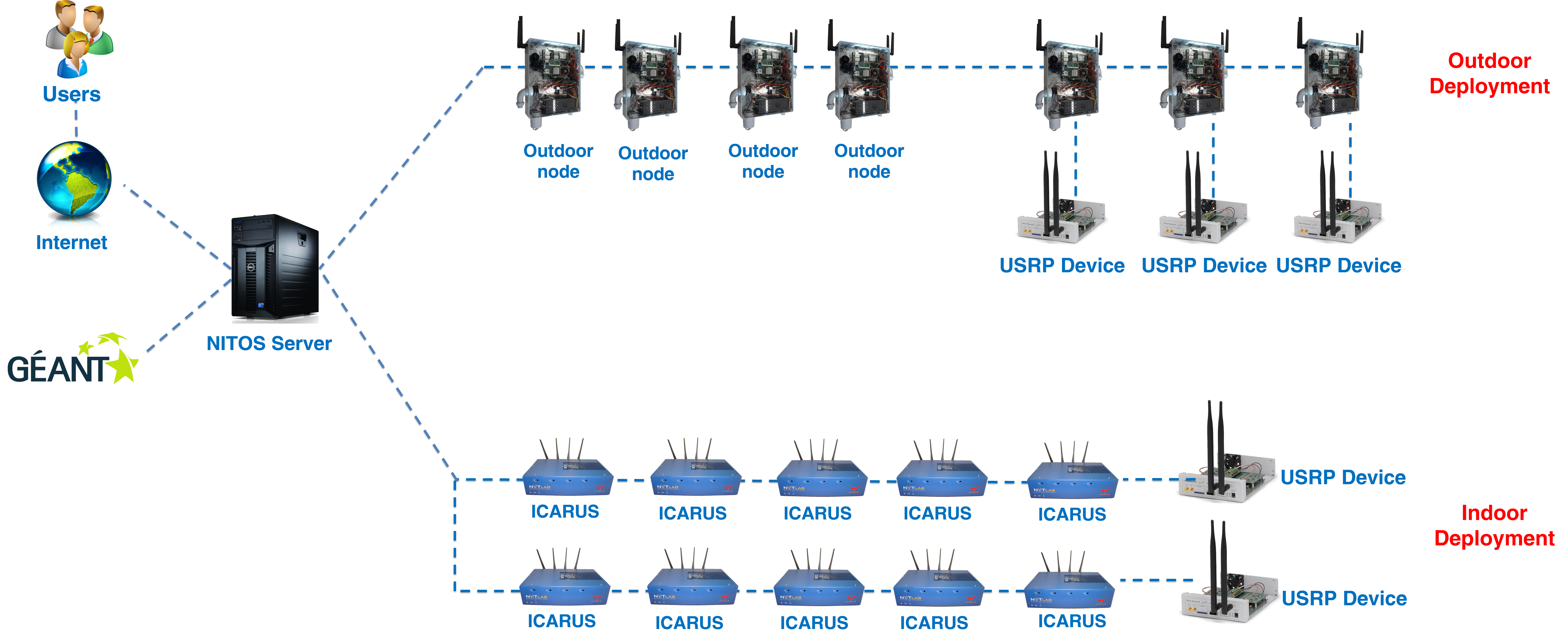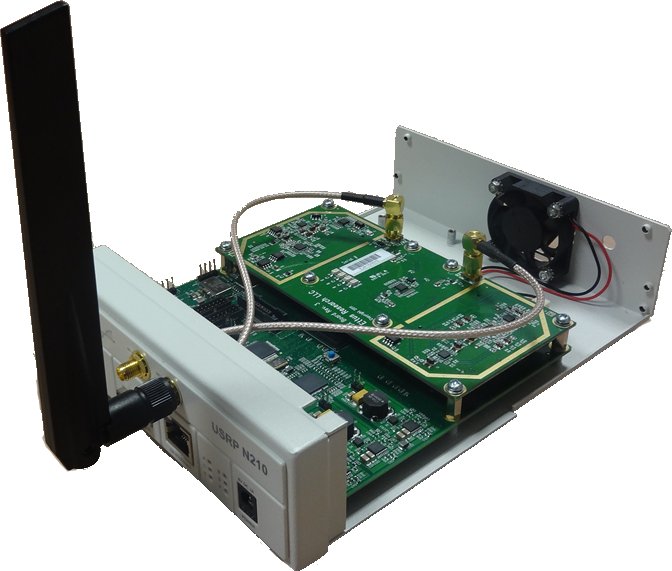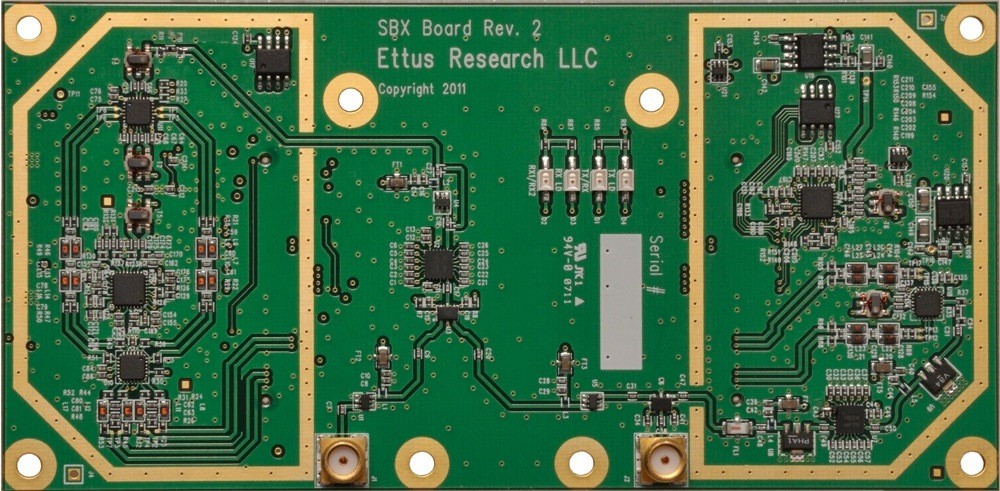NITlab developed a software defined radio (SDR) testbed that consists of 18 Universal Software Radio Peripheral (USRP) devices attached to the NITOS wireless nodes. USRPs allow the researcher to program a number of physical layer features (e.g. modulation), thereby enabling dedicated PHY layer or cross-layer research.

More specifically, USRPs connect to a host computer through a high-speed USB or Gigabit Ethernet link, which the host-based software uses to control the USRP hardware and transmit/receive data. Some USRP models also integrate the general functionality of a host computer with an embedded processor that allows the USRP Embedded Series to operate in a standalone fashion.
USRPs are commonly used with the GNU Radio software suite to create complex software-defined radio systems. The USRP product family includes a variety of models that use a similar architecture. A motherboard provides the following subsystems: clock generation and synchronization, FPGA, ADCs, DACs, host processor interface, and power regulation. These are the basic components that are required for baseband processing of signals. A modular front-end, called a daughterboard, is used for analog operations such as up/down-conversion, filtering, and other signal conditioning. This modularity permits the USRP to serve applications that operate between DC and 6 GHz.
In stock configuration the FPGA performs several DSP operations, which ultimately provide translation from real signals in the analog domain to lower-rate, complex, baseband signals in the digital domain. In most use-cases, these complex samples are transferred to/from applications running on a host processor, which perform DSP operations.
USRP Devices
NITlab has equipped the SDR testbed with 6 USRP1, 4 USRP N210 and 4 USRP B210 devices, placed in such way to cover as much area as possible of the wireless testbed. Details for each device are stated below.

USRP1
The USRP1 is the original USRP product and consists of:
- Four high-speed analog-to-digital converters, each capable of 64 MS/s at a resolution of 12-bit, 85 dB SFDR (AD9862).
- Four high-speed digital-to-analog converters, each capable of 128 MS/s at a resolution of 14-bit, 83 dB SFDR (AD9862).
- An Altera Cyclone EP1C12Q240C8 FPGA.
- A Cypress EZ-USB FX2 High-speed USB 2.0 controller.
- Four extension sockets (2 TX, 2 RX) in order to connect 2–4 daughterboards.
- 64 GPIO pins available through four BasicTX/BasicRX daughterboard modules (16 pins each).
- Up to 8 MHz of RF bandwidth in the receive

USRP N210
USRP N210 is part of the networked series and one of the highest performing class of hardware of Ettus Research. The USRP N210 consists of:
- A Xilinx Spartan-3A DSP 3400 FPGA
- Gigabit Ethernet interface
- Dual 100 MS/s, 14-bit, analog-to-digital converter
- Dual 400 MS/s, 16-bit, digital-to-analog converter
- Up to 50 MHz of RF bandwidth in the receive
- External Inputs for 10 MHz and 1 PPS signals (SMA)
- Optional GPS Disciplined Oscillator
- Ettus Research MIMO Cable that can be used to synchronize two USRP devices (sold separately)
- Support for timed commands and LO alignment with the SBX daughterboard

USRP B210
USRP B210 is part of the bus series and provides a fully integrated, single-board, Universal Software Radio Peripheral (USRP™) platform with continuous frequency coverage from 70 MHz – 6 GHz. The USRP B210 consists of:
- A Xilinx Spartan-6 XC6SLX150 FPGA
- USB 3.0 SuperSpeed Interface
- 61.44 MS/s, 12-bit, analog-to-digital converter
- 61.44 MS/s, 12-bit, digital-to-analog converter
- Up to 56 MHz of RF bandwidth in 1x1
- Up to 30.72 MHz of RF bandwidth in 2x2
- Frequency range 70 MHz to 6 GHz
- 2 TX & 2 RX Half or Full Duplex
RF Daughterboards
NITlab has equipped the USRPs with 2 different daughterboards, the XCVR2450 and the SBX which are the most appropriate for the multiple areas of the research taken place in NITOS testbed (802.11a/b/g/n, LTE, WiMAX, ZigBee). Descriptions for both daughterboards are stated below.

XCVR2450 2.4 GHz-2.5 GHz
The XCVR2450 is a high-performance transceiver intended for operation 2.4 GHz and 5.9 GHz range. Filtering on the XCVR2450 provides exceptional selectivity and dynamic range in the intended bands of operation. The typical power output of the XCVR2450 is 100 mW. Example applications include public safety, UNII, ISM, Japanese wireless and UWB development platforms. The XCVR2450 is a half-duplex transceiver.

SBX 400-4400 MHz Rx/Tx
The SBX is a wide bandwidth transceiver that provides up to 100 mW of output power, and a typical noise figure of 5 dB. The local oscillators for the receive and transmit chains operate independently, which allows dual-band operation. The SBX is MIMO capable, and provides 40 MHz of bandwidth. The SBX is ideal for applications requiring access to a variety of bands in the 400 MHz-4400 MHz range. Example application areas include Wi-Fi, WiMax, S-band transceivers and 2.4 GHz ISM band transceivers.
You can proceed to NITOS Portal for experimentation on SDR resources.

